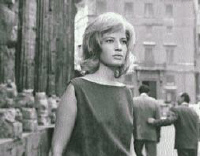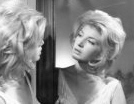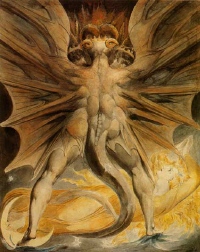 ELLIPTICAL NOTES ON ANTONIONI'S L'AVVENTURA
ELLIPTICAL NOTES ON ANTONIONI'S L'AVVENTURA"And a great portent appeared in heaven, a woman clothed with the sun, with the moon under her feet, and on her head a crown of twelve stars; she was with child and she cried out in her pangs of birth, in anguish for delivery." --Revelations 12:1,2
L'AVVENTURA (1960), Michelangelo Antonioni - "No ideas without things ..." ... or so contemporary, materialist theory proclaims ... Yet, is cinema a thing ??? ... L'Avventura certainly contains things ... nominally ... Raw physical facts, plus bourgeois boredom ... decadence and unparalleled, yet listless wantonness ... Much has been said and written about this film in which nothing much happens ... least of all the resolution of the dissolution/dissipation at its gnawed-at heart ... its troubled reception at Cannes ... and ... its subsequent critical acclaim anyway ... How it re-launched Antonioni's career ... re-inspired/inspired French nouvelle vague cinema ...Yet ... Antonioni's L'Avventura leaves one engulfed by a great dulling silence ... when it has finished ... It is a stunning achievement to silence everything ... at least momentarily ... What is cinematic realism (neo-realism) ??? ... It is what it is ... Throughout the film, despite each passing scenario, the elemental datum of the earliest scenes set upon the barren island (Lisca Bianca), where Anna disappears, remains ... a fragmented, near-soulless island landscape formed by ancient volcanic debris ... as sullen as Antonioni's world view ... a virtual wasteland perched at the edge of time ...
 After this perhaps false start, plot-wise at least, after Anna is despatched to 'nowhere', Antonioni's camera follows Claudia (Monica Vitti) more closely, as she becomes the center of the storm that appears to be gathering ... but never arrives .. Her hands... her eyes and hair ... her interactions with the world she almost inhabits ... She stands often at the window, the landscape of the city or the mountains around Palermo vying for preeminence ... until she steps aside ... She struggles against the elemental forces within her as much as without ... suppressing them ... a windswept panorama ... countered by the emptiness of opulent interiors ... traveling through vacant towns ... climbing empty streets ... suddenly surrounded by lascivious, crowding, anonymous, hungry suitors ... Her beauty and the beauty of the under-populated Sicilian landscape are one and the same (interchangeable ??? ...) in Antonioni's lens ... they converge on an elemental, unsatiated hunger ... The silence (Claudia's silence ??? ...) is a force of nature -- a metaphysical force within nature -- that Antonioni teases forth ... mercilessly ... A raw, nullifying force that mirrors the materialistic, nihilistic void of things disconnected from other things ... people adrift in a sea of ennui ...
After this perhaps false start, plot-wise at least, after Anna is despatched to 'nowhere', Antonioni's camera follows Claudia (Monica Vitti) more closely, as she becomes the center of the storm that appears to be gathering ... but never arrives .. Her hands... her eyes and hair ... her interactions with the world she almost inhabits ... She stands often at the window, the landscape of the city or the mountains around Palermo vying for preeminence ... until she steps aside ... She struggles against the elemental forces within her as much as without ... suppressing them ... a windswept panorama ... countered by the emptiness of opulent interiors ... traveling through vacant towns ... climbing empty streets ... suddenly surrounded by lascivious, crowding, anonymous, hungry suitors ... Her beauty and the beauty of the under-populated Sicilian landscape are one and the same (interchangeable ??? ...) in Antonioni's lens ... they converge on an elemental, unsatiated hunger ... The silence (Claudia's silence ??? ...) is a force of nature -- a metaphysical force within nature -- that Antonioni teases forth ... mercilessly ... A raw, nullifying force that mirrors the materialistic, nihilistic void of things disconnected from other things ... people adrift in a sea of ennui ... Lampedusa's Palermo ... it is here, a surplus value in the frames of the island idyll ... the villa ... after the search party has dissipated ... and the aimless, consumptive partying has resumed ... this second villa echoing the villa in the opening scene where Anna's father seems to be fatalistically adjudicating the subdivision of the surrounding land for de luxe tract housing ... Beauty again seems to crowd the screen, albeit a fading beauty ... And the architect (Sergio), Claudia's seducer (that is, missing Anna's morally-bereft boyfriend ...), comments from the heights of a village church how the ancient town was assembled with an eye to each building's "setting" ... that the whole comprises and/or transcends the parts ... an idle comment perhaps (tossed over the parapet ...), given his work as architect consists of cost-estimating for a giant construction firm ... And, if Antonioni is always playing with the implicit alienation in things ("they built buildings to last centuries, today maybe ten or twenty years ..."), it is evident that his reading of things is more finely calibrated than his characters might individually portray ... Thus his characters resemble nothing if not puppets cut loose and wandering ... floundering ... even as he indulges the occasional de Chirico-esque deserted street (usually seen from above, from a window ...) ... And ... as the young, bored aristocratic would-be painter at the villa in Palermo suggests that no landscape is as beautiful as a woman ... perhaps it is a tenet of neo-realism to anchor one's critical vision in an elemental acceptance of things however disconnected or set adrift ... Accepting things as they are to merely survive ??? ... to get on with things ??? ...
Lampedusa's Palermo ... it is here, a surplus value in the frames of the island idyll ... the villa ... after the search party has dissipated ... and the aimless, consumptive partying has resumed ... this second villa echoing the villa in the opening scene where Anna's father seems to be fatalistically adjudicating the subdivision of the surrounding land for de luxe tract housing ... Beauty again seems to crowd the screen, albeit a fading beauty ... And the architect (Sergio), Claudia's seducer (that is, missing Anna's morally-bereft boyfriend ...), comments from the heights of a village church how the ancient town was assembled with an eye to each building's "setting" ... that the whole comprises and/or transcends the parts ... an idle comment perhaps (tossed over the parapet ...), given his work as architect consists of cost-estimating for a giant construction firm ... And, if Antonioni is always playing with the implicit alienation in things ("they built buildings to last centuries, today maybe ten or twenty years ..."), it is evident that his reading of things is more finely calibrated than his characters might individually portray ... Thus his characters resemble nothing if not puppets cut loose and wandering ... floundering ... even as he indulges the occasional de Chirico-esque deserted street (usually seen from above, from a window ...) ... And ... as the young, bored aristocratic would-be painter at the villa in Palermo suggests that no landscape is as beautiful as a woman ... perhaps it is a tenet of neo-realism to anchor one's critical vision in an elemental acceptance of things however disconnected or set adrift ... Accepting things as they are to merely survive ??? ... to get on with things ??? ... Anna's disappearance is matched by the second disappearance of the significance of the first disappearance (but we are told "40,000 people disappear in Italy every year" ...) ... The non-search for Anna devolves to an almost-carnivalesque party for the idle rich at a fashionable hotel (set in San Domenico Palace ...) ... Finally ... mugging before/in the mirror of her bedroom ... and she has earlier all but fallen asleep in her open suitcase, on the floor ... Claudia's boredom/insomnia swallows her ... she is crawling towards accepting the broken state of things ... to become jaded as well, as her new upperclass friends ... Sergio's tryst with a prostitute nearly topples her ... until she places her hand on his head ... stabilizing things ??? ... bowing again to/before 'reality' and its brutal force leveling all things ... its grip on heartless people ... Sergio's tears ??? ... our tears ??? ... Antonioni's vision ??? ... our vision ??? ... our blindness ??? ... Whichever these things might coincide with, then (1960) or now (2003), redemption remains off-screen ... unrealized ... unreal ... almost forgotten ... the search called off ... In Antonioni's films, it is almost always in the psyche of the female protagonists that some-thing else is struggling to be born (saved ??? ...) ... against which the rogue state of the anaestheticized male predominates ... His female protagonists succumb to this withering force, this 'state' (sign of a prescriptive 'statism' ??? ...) ... over and over ... lost again, buried, bored ... Nevertheless ... the apparent moral quandry (miasma) of these circa-1960 films is not without its secret agenda ... no matter how deeply buried below the wreckage ... Antonioni's cinematic soul is the proverbial (Blakean ??? ...) Woman Clothed with the Sun ... Perhaps a gesture towards Cinema Herself ??? ...
Anna's disappearance is matched by the second disappearance of the significance of the first disappearance (but we are told "40,000 people disappear in Italy every year" ...) ... The non-search for Anna devolves to an almost-carnivalesque party for the idle rich at a fashionable hotel (set in San Domenico Palace ...) ... Finally ... mugging before/in the mirror of her bedroom ... and she has earlier all but fallen asleep in her open suitcase, on the floor ... Claudia's boredom/insomnia swallows her ... she is crawling towards accepting the broken state of things ... to become jaded as well, as her new upperclass friends ... Sergio's tryst with a prostitute nearly topples her ... until she places her hand on his head ... stabilizing things ??? ... bowing again to/before 'reality' and its brutal force leveling all things ... its grip on heartless people ... Sergio's tears ??? ... our tears ??? ... Antonioni's vision ??? ... our vision ??? ... our blindness ??? ... Whichever these things might coincide with, then (1960) or now (2003), redemption remains off-screen ... unrealized ... unreal ... almost forgotten ... the search called off ... In Antonioni's films, it is almost always in the psyche of the female protagonists that some-thing else is struggling to be born (saved ??? ...) ... against which the rogue state of the anaestheticized male predominates ... His female protagonists succumb to this withering force, this 'state' (sign of a prescriptive 'statism' ??? ...) ... over and over ... lost again, buried, bored ... Nevertheless ... the apparent moral quandry (miasma) of these circa-1960 films is not without its secret agenda ... no matter how deeply buried below the wreckage ... Antonioni's cinematic soul is the proverbial (Blakean ??? ...) Woman Clothed with the Sun ... Perhaps a gesture towards Cinema Herself ??? ...Gavin Keeney (September 2003)
Apologies ... The RTF version was deleted 09/28/05 ...
L'Avventura - Cino del Duca, 1960 - Cinematography: Aldo Scavarda, Scenography: Piero Poletto, Music: Giovanni Fusco - 145 minutes - B&W - Italian w/ English subtitles - w/ Monica Vitti, Lea Massari, Gabriele Ferzetti, Renzo Ricci, James Addams
See also A propos [de] l'Humanité: Resnais/Antonioni (Samizdat)
Antonioni Bibliography (UC Berkeley)
Images (above) - Claudia (Monica Vitti) as "The Woman Clothed with the Sun"
 CRITICAL NOTES
CRITICAL NOTES"Antonioni's study of the human condition at the higher social and economic levels -- a study of adjusted, compromising modern man, afflicted by short memory, thin remorse, the capacity for easy betrayal. The characters are active only in trying to discharge their anxiety: sex is their sole means of contact. Too shallow to be truly lonely, they are people trying to escape their boredom by reaching out to one another and finding only boredom once again. Because the film is subtle and ascetic, yet laborious about revealing its meanings, it suggests Henry James when he 'chewed more than he bit off.' Visually, it's extraordinary: a calm hangs over everything -- Antonioni's space is a vacuum in which people are aimlessly moving. Searchers and lost are all the same: disparate, without goals or joy. This is upper-class neo-realism -- the poetry of moral and spiritual poverty. There had been nothing like it before, and it isn't fair to blame this movie for all the elegant sleepwalking that followed. There's something great here -- a new mood, a new emotional rhythm -- even with all the affectation." --Pauline Kael
"I consider La Noia (one of the most serious and beautiful books by Moravia) and Antonioni's L'Avventura as the greatest cultural events of the year [1960 ...] It is a picture of great, unsparing severity, of keen morality, because it is firmly grounded in today's humanity, not in gratuitous or literary abstraction [...] As a description of society L'Avventura is just perfect. Its Southern Italian setting, for instance -- the inferno of underdevelopment contrasted with the affluent inferno [of the North] -- is the most truthful and the most impressive that ever appeared on the screen, without the least indulgence to populism or local colour." --Italo Calvino
Image (above) - William Blake's "The Great Red Dragon and the Woman Clothed with the Sun" (c.1806-1809)
Regarding Seymour Chatman's Michelangelo Antonioni (Taschen, 2004), cliquez ici ...

